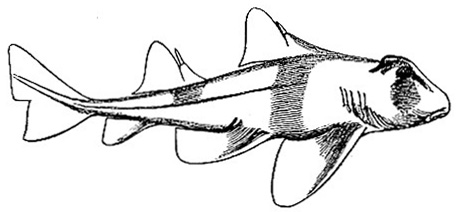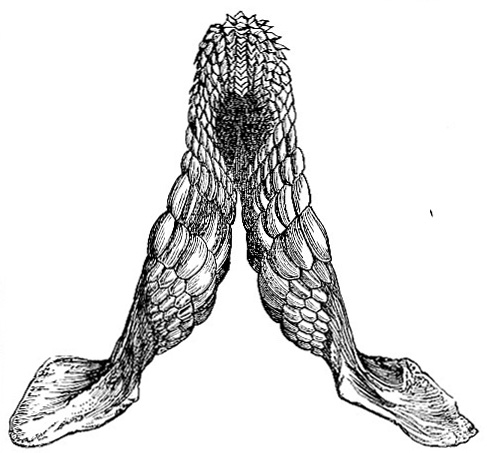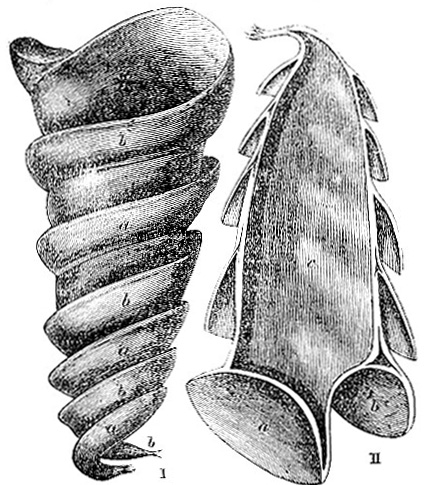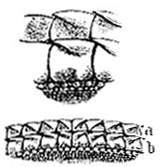1902 Encyclopedia > Shark > Crossorhinus. Port Jackson Shark. Spiny or Piked Dog Fish.
The genus Crossorhinus, of which three species are known from the coasts of Australia and Japan, is remarkable as the only instance in this group of fishes in which the integuments give these inactive ground-sharks, whilst they lie concealed watching for their prey, what may be called a "celative" rather than a "protective" resemblance to their surroundings.
Skinny frond-like appendages are developed near the angle of the mouth, or form a wreath round the side of the head, and the irregular and varied-coloration of the whole body closely assimilates that of a rock covered with short vegetable and coralline growth. This peculiar development reminds us of the similar condition in the sea devil (Lophius), where it serves also to conceal the fish from its prey, rather than to protect it from its enemies. The species of Crossorphinus grow to a length to 10 feet.

Fig. 6 -- Cestracion galeatus
The so-called Port Jackson Shark (Cestracion) is likewise a littoral form. Besides the common species (C. philippi), three other closely allied kinds from the Indo- Pacific are known. The genus, which is the only existing type of a separate family, is one of special interest, as similar forms occur in Primary and Secondary strata. The jaws are armed with small obtuse teeth in front, which in young individuals are pointed, and provided with from three to five cusps.

Fig. 7 -- Upper Jaw of Port Jackson Shark (Cestracion philippi) (x 1/2.)
The lateral teeth are larger, pad-like, twice as broad as long and arranged in oblique series (fig. 7), an arrangement admirably adapted for the prehension and mastication of crustaceans and hard- shelled animals. The fossil forms far exceeded in size the living, which scarcely attain to a length of 5 feet.

Fig. 8 -- Eggshell of the Cestracion philippi. I, an external view; II, section; a and b, two spiral ridges; c, cavity for the ovum.
The shells of their eggs are not rare in collections, being found thrown ashore like those of our dog-fishes. The shell in pyriform, with two broad lamellar ridges each wound edgewise five times round it (Fig. 8).
The Spiny or Piked Dog-Fish (Acanthias) inhabits, like the majority of littoral genera of sharks, the temperate seas of both the northern and southern hemispheres. For some part of the year it lives in deeper water than the sharks already noticed, but at uncertain irregular times it appears at the surface and close inshore in almost incredible numbers. Couch says that he has heard of 20,000 having been taken in a sean at one time; and in March 1858 the newspaper reported a prodigious shoal reaching westward to Uig, whence it extended from 20 to 30 miles seaward, and in an unbroken phalanx eastward to Moray, Banff, and Aberdeen. In the deep fjords of Norway, and indeed at every station of which a shoal of these fishes has taken temporary possession, line-fishing has to be suspended during the time of their visit, as they cut the lines with their scissors like teeth.

Fig. 9 -- Teeth of Acanthias vulgaris
As expressed by the name, these fishes are distinguished from the other British littoral sharks by each of the two dorsal fins being armed in front by an acute spine. They do not posses an anal fin. Their teeth are rather small, placed in a single series, with the point so much turned aside that the inner margin of the tooth forms the cutting edge (fig. 9). The spiny dog-fish are of a greyish colour, with some whitish spots in young specimens, and attain to a length of two or three feet. They are viviparous, the young being produced throughout the summer months. It is stated that in the northern islands of Great Britain they are dried for food, and that their livers yield a large quantity of oil.
Read the rest of this article:
"Shark" Article - Table of Contents
|



